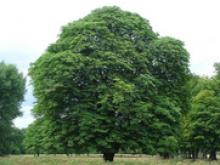The story of the chestnut is an all-too-familiar one, and a warning to anyone who doubts the danger of invasive species and diseases. The American chestnut was central to life in the 1700s and 1800s.
It grew quickly and large, and dominated the forests of the Eastern seaboard from Appalachia to Maine. Its wood and chestnuts were critical to the economic success of the families in its range, and its beautiful spreading shape was the pride of many towns.
The chestnut blight was first identified in 1904. Chestnut blight is a fungus which was accidentally introduced around 1900, possibly through imported chestnut wood used in the lumber industry. The fungal spores spread on the wind, and destroyed the American chestnut within a shockingly short space of time.
Chestnut blight enters the tree through any cracks or break in the bark. It then multiplies, creating a lump called a "canker." As the canker grows, it girdles the tree, which kills every part of the tree above the canker.
It only took about 40 years for the American chestnut to be wiped out. An estimated four billion trees were killed by the fungus, reduced to stumps which still occasionally send out shoots. Sadly, the shoots all succumb to the fungus before they can grow very large.
Some very small stands of American chestnut survived. They were far enough away from the blight that they remained uninfected. These small stands in California and the Pacific Northwest, as well as a tiny colony recently discovered in Georgia, form the basis of the new hybridization program.
(Note: the American chestnut is not the same as the Horse chestnut, Aesculus hippocastanum, which is an unrelated tree with a similar-looking nut. Horse chestnut trees are common in the Pacific northwest. However, the nuts of the Horse chestnut are poisonous. Not to be roasted and eaten, over an open fire or otherwise!)
The American Chestnut Foundation is working to restore the American chestnut, by hybridizing it with Chinese chestnut trees which seem to be immune to the blight. Their work is slow, because a generation for a tree can be a very long time indeed. Luckily, the American Chestnut Foundation has an ample supply of patience.
There is also some interesting work being done with a virus which kills the blight fungus. If this research pans out, chestnut trees could be inoculated with the virus - similar to a human vaccination. This virus can also be directly injected into the cankers caused by the fungus, to beat it back and allow the infected tree to survive.
The story of the American chestnut is also, sadly, the story of a monoculture. The chestnut's success was its very undoing, as it was so common that it grew in long stretches unbroken by any other tree species. Its narrow genetic makeup, and its sheer overwhelming numbers, made it a natural target for a devastating disease.
Photo credit: Flickr/silverfox09
